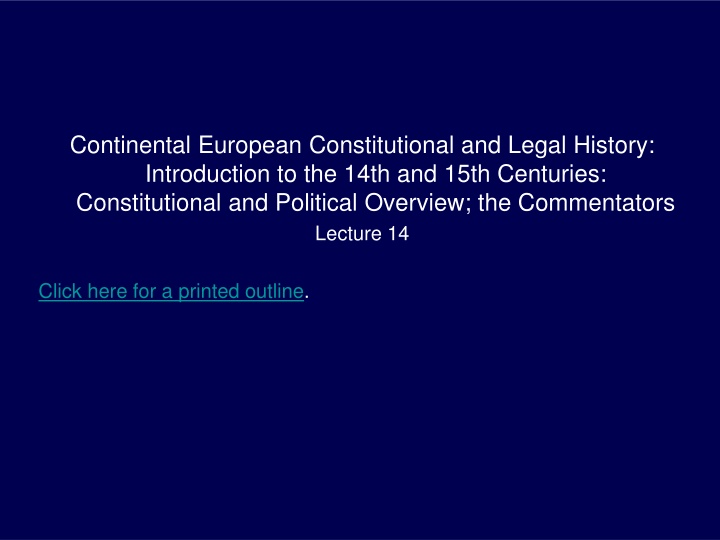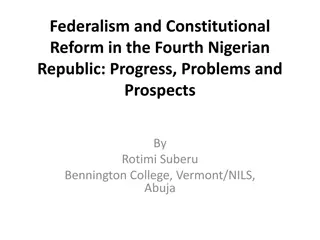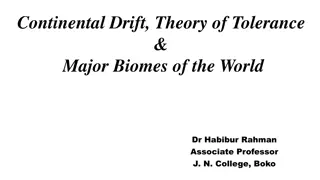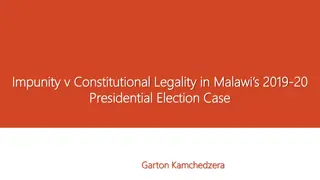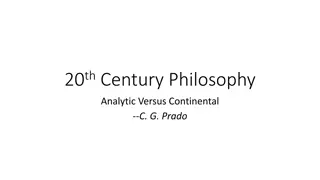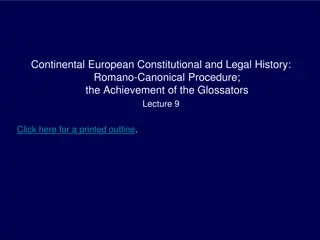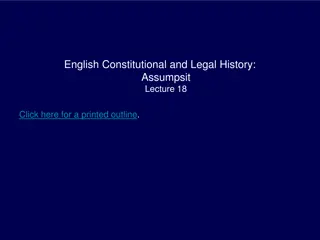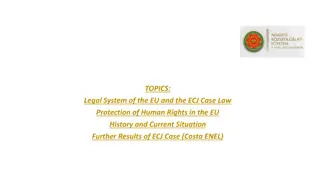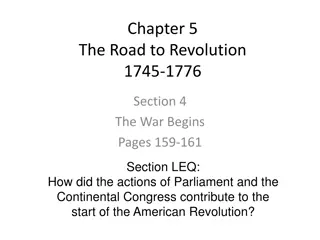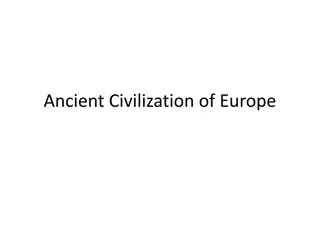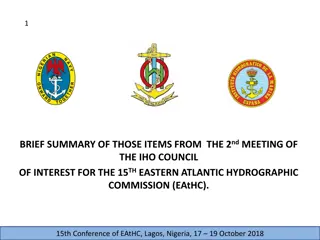Constitutional Evolution in Continental Europe During the 14th and 15th Centuries
The political and constitutional landscape of Continental Europe from the 14th to 15th centuries, delving into key events like the Black Death, papal schisms, and the emergence of conciliarism that shaped legal history. Learn about the power struggles, dynamics between local churches and the papacy, and the societal impacts of historical events during this significant period.
Uploaded on Mar 08, 2025 | 3 Views
Download Presentation

Please find below an Image/Link to download the presentation.
The content on the website is provided AS IS for your information and personal use only. It may not be sold, licensed, or shared on other websites without obtaining consent from the author.If you encounter any issues during the download, it is possible that the publisher has removed the file from their server.
You are allowed to download the files provided on this website for personal or commercial use, subject to the condition that they are used lawfully. All files are the property of their respective owners.
The content on the website is provided AS IS for your information and personal use only. It may not be sold, licensed, or shared on other websites without obtaining consent from the author.
E N D
Presentation Transcript
Continental European Constitutional and Legal History: Introduction to the 14th and 15th Centuries: Constitutional and Political Overview; the Commentators Lecture 14 Click here for a printed outline.
Road Map for the Rest of the Course Three centuries in the next three weeks. Two weeks on the 14th and 15th centuries and a week on the 16th, followed by two weeks on 17th century and beyond. Today and a week from Monday, and week from that Monday: constitutional and political background basically in chronological order. Session in the HLS Treasure room on Wed. Mar. 30, Covid regulations permitting. For law and grad students statements of your paper topic (i.e., the text on which you are going to write) due Wed. Mar. 30. First draft of paper due Mon. Apr. 11.
The Later Middle Ages The later Middle Ages as history s stepchild. The tenor of the times: Johan Huizinga, The Autumn of the Middle Ages. It s an important period for legal historian because the sources start to proliferate.
The plague 1347 50, The Black Death, Europe-wide invasion of plague. By 1350 between one-third and one-half of the European population was dead. The plague hit an already weakened population. The plague struck again and again. It was still a problem in London in the 17th century. It hit the cities harder than it did the countryside. It hit the poor harder than it did the rich. Resulting in: A reduction in population that lasted for a century and half. A increase of wealth of the laboring classes. A continual drain of population from the countryside to the towns. A change in mentality? Can we connect this development with the rise of voluntarism? .
The papacy and the councils 1305 1378, Babylonian captivity of the papacy at Avignon The creation of the Roman Rota, which paradoxically had the tendency to enhance the power of local churches. Tighter papal control over appointments in local churches, which had the opposite effect. The rapacity of the Avignonese papacy, necessitated, to some extent, by loss of revenue from the Papal States. The disputed papal election of 1378, which led to: 1378 1417, the Great Schism (Urban VI [Rome], Clement VII [Avignon]), which led to: 1409 1447, the age of councils : Pisa, 1409 Constance, 1414 1417 (election of Martin V) Basel, 1431 1449 Ferrara-Florence, 1438 1445 (The last two named began as one and met intermittently.)
Conciliarism The church is a vast corporation (congregatio fidelium), the general council is its representative body, it can sit over and depose popes. The early canonists had also explored the problem of what was to be done with a pope who strayed. The most commonly raised problem was what was to be done with an heretical pope. The tradition that no one could judge the pope was strong. It was one of the foundations of the theory of papal monarchy, even before the idea became current that the pope possessed plenitudo potestatis. Nonetheless, no canonist could countenance the notion of an heretical pope, and a number of them were willing to extend the idea to a pope who was guilty of serious crimes. The standard resolution of the problem was to say that a general council could depose a pope for heresy, perhaps also for crimes. Writing at the height of the controversy between Philip the Fair and Boniface VIII at the beginning of the 14th century, John of Paris, was to extend the notion that the council is more truly representative of the church than is the pope.
Conciliarism (contd) Johannes Monachus held that the pope must consult with the cardinals before promulgating general legislation. William Durantis the Younger espoused the powers of a general council in the effort to restore authority to the bishops that he thought was being eaten away by the papacy. The possibility that the ideas of the early conciliarists spilled over into secular governance. Civilians and canonists sat on the commission that advised about the deposition of Richard II of England in 1399. For the church, however, conciliarism was a failure.
France and England With the extinction of the direct Capetian line upon the death of the last of Philip the Fair s sons without issue in 1328, the next in line to the throne was Edward III of England in the right of his mother Isabella who was a daughter of Philip the Fair. Against this claim was the fact that since the 10th century no woman had ruled over France, indeed, it could be argued that there never was a time when a woman reigned over France. In terram Salicam mulier ne succedeat ( a woman may not inherit Salic land ). The first phase of the war went well for the English and badly for the French. When Henry V of England arrived in France in 1415, he arrived in country that was deeply divided. The Burgundians were on his side. The French recovery under Charles VII owes much to one of the most extraordinary women of history, Joan of Arc. Charles VII who appears as a fool in all the stories, was no fool. He bided his time, and when Henry V died leaving England with a 9-month-old king, he recovered most of the old royal domain. His successor Louis XI turned his attention to the problem of Burgundy. At his death France was back to where it was when Philip the Fair died.
The Empire 1356, Charles IV, the Golden Bull, 7 electors: archbishops of Mainz, Trier, K ln; king of Bohemia, count Palatine of the Rhine, margrave of Brandenburg, duke of Saxony; notable for their absence: the pope, the duke of Bavaria. The real power of the emperor continued to decline. The empire had freed itself from entanglement with the papacy, but possession of the imperial crown became insignificant. The history of Germany in this period is the history of more than a hundred small principalities.
Italy The struggles of black Guelfs against Ghibellines and white Guelfs. The use of a podest , a job that law professors frequently had, despite its undeniable risks. Milan, despotism of the Visconti (14th c to 1447), rise of the Sforza. Venice, oligarchic republic, defeat of Genoa in 1380. Florence, republic, increasingly under control of the Medici in 15th c. Urbino, taken over by the condottiere Federico da Montefeltro in 1444. Papal states, alternation of humanist and politician popes, the Borgia. Naples, briefly united with Sicily under Alfonso V the Magnanimous, king of Aragon, 1416 1458, divided at his death.
Italy (contd) Federico da Montefeltro, portrait by Piero della Francesca 1473 X 1475, in the Uffizi Gallery in Florence.
Local law in Italy 1162, Pisa: Breve Consulum Pisanae civitatis 1233, Pisa: Constituta legis et usus 1286, Pisa: Breve Pisani communis 1303, Pisa: Breve Pisani communis 1170, Milan: Act of the consuls (regulating relations between lords and tenants) 1216, Milan: Liber Consuetudinum Mediolani 1396, Milan: Statuta Mediolani (8 bks. promulgated just after Gian Galezzo Visconti become duke of Milan, contains much of the now-lost compilations of 1330 and 1342) 1246 1324, Florence: fragments only survive of annual legislation 1293, Florence: Ordinamenta Iustitiae (triumph of the merchants over the magnates) 1325, Florence: Statuto del Capitano del Popolo; Statuto del Podest 1414, Florence: Statuta populi et communis Florentiae
Castile and Aragon In Castile, a series of disputed successions from Alfonso X to Isabella. During the reign of Alfonso XI (1348), we get the Ordinamento de Alcala. Ferdinand I of Aragon was the younger brother of Henry III of Castile. (Their mother, Eleanor, was the oldest daughter of Peter IV of Aragon.) This connection made the union under Ferdinand II of Aragon and Isabella of Castile easier. Kings of Aragon, with a couple of exceptions, were also kings of Sicily. If they were not, the king of Sicily was frequently a close relative. The relationship with Naples was more complicated. The union of the crowns Castile and Aragon, under Ferdinand and Isabella, led to a series of events that you probably learned about in the fifth grade.
A way to think about these developments A widening of the horizons of ordinary people. The rise of the phenomenon of lay spirituality. The emergence of the vernacular. A crisis of legitimacy? The ultimate decline of representative institutions.
The commentators: civilians Odofredus de Denariis ( 1265) (Bologna, all CJCiv) Jacobus de Ravaniis (Jacques de R vigny) ( 1296) (Orl ans, all CJCiv) Dinus de Mugello ( c.1303) (Bologna; 1st consilia, De regulis iuris) Petrus de Bellapertica (Pierre de Belleperche) ( 1308) (Orl ans; Inst., Dig. Nov., Cod.) Oldradus de Ponte ( 1335) (Bologna, Pauda; consilia) Cinus de Pistoia (1270 1336) (imperial judge, Siena; Cod.; teacher of Bartolus) Johannes Faber (Jean Fauri) ( c.1340) (probably not a teacher; Inst.) Bartolus de Saxoferrato (1313 1357) (Perugia; all CJCiv; teacher of Baldus) Baldus de Ubaldis (1319/20 or 1327 1400) (Perugia, Pavia; most of CJCiv and some CJCan, consilia) Johannes Christopherus Portius (Parcus, Porcus) (fl. 1434) (Inst.) Paulus de Castro ( p.1441) (Florence; Dig., some Cod., consilia) Alexander Tartagnus de Imola ( 1477) (Bologna; consilia) Jason de Mayno (1438 1519) (Padua, teacher of Alciatus; consilia) Philippus Decius (1454 c.1535) (Pisa; consilia) Robertus Maranta (c. 1476 c. 1534 (Naples, proceduralist)
The commentators: civilians (contd) Like the glossators, almost all of the commentators were teachers. Just as the school of Martinus had broken away in the mid-12th century and was brought back into the Bolognese mainstream by Azo and Accursius, so too, the commentators brought back into the mainstream the work of the French professors of the late 13th century. By and large, the Italian commentators are associated with the imperial (Ghibelline, white Guelf) faction of Italian politics. Increasing use of custom and statute. Incorporation of canon law. Consilia are largely a new form of literature in this period. Tractatus are not new, but there are a lot of them.
The commentators: civilians (contd) An Ocean of Law . The Harvard Law School s copy of the Tractatus universi iuris (Venice 1584) is bound in 29 physical volumes, 17 inches high, 18 tomes in 25 physical volumes and 4 physical volumes of indices.
The commentators: canonists Henricus de Segusio (Hostiensis) ( 1271) (diplomat, prelate; X) Johannes Andreae ( 1348) (Bologna; X, VI, Clem.) Aegidius Bellamera (Gilles Bellem re) ( 1407) (auditor of Rota; X, Decisiones Rotae) Antonius de Butrio ( 1408) (Bologna; X) Franciscus Zabarella (Cardinalis) ( 1417) (Padua; X, Clem.) Nicolaus de Tudeschis (Panormitanus, Abbas Siculus) ( 1443) (Siena; X, VI) Johannes de Turrecremata (Torquemada) ( 1468) (cardinal; Decreta)
The commentators: canonists (contd) Encyclopedic commentaries Continued development of procedure The development of conciliarism Consilia Case reports Tractatus
The development of the ius commune Among proceduralists even in the 13th century the distinction between canonists and civilians will not hold water. We have indicated above that the distinction among the academics was becoming increasingly blurred in the later MA. Among the practicing lawyers it is hardly to be found at all. Both canonists and civilians get legal jobs in the church. Some churchmen with law degrees have degrees only in civil law. Some laymen have doctorates in both laws. Johannes Andreae was a layman and seems to have had a degree only in canon law. Professional associations of lawyers from doctors commons in England to the guilds of lawyers in Italy rarely distinguish between holders of the two kinds of degrees.
The development of the ius commune(contd) By the 14th century lawyers all over Europe are referring to the ius commune, the common law. It means the law that Europeans have in common, a combination of Roman and canon law, to be distinguished from the customary law of a particular city or region or the law embodied in the statutes or fueros of a particular city or region. A notion of a hierarchy of sources prevailed over most of Italy and southern France as well. Local statute was primary. If it applied to the case, it was binding. After that came the ius commune. But the power of the ius commune was even greater than the hierarchy would seem to suggest, because the local statutes were interpreted in the light of the ius commune. The terminology and structure of the ius commune was the terminology and structure that every trained jurist used, and jurists were increasingly used as judges and consultors. Some of them participated in the drafting of the statutes for the city-states.
The development of the ius commune(contd) None of this would have been have possible had it not been for the effort that had been going on for over two centuries to tame the sources, to make Roman law and the vast assemblage of canonic sources usable in a world far different from that in which most them had been written. None of it, too, would have been possible had the jurists not shared a common training and a common methodology.
